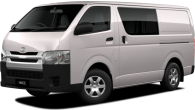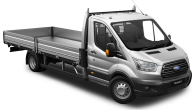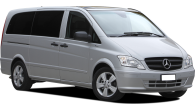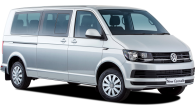You know how some of the best places to spend a night on the town are the ones nobody else knows about?
That quiet little restaurant or cocktail bar with excellent service that you never have trouble getting a table at?
The Kia Carnival has arguably been the automotive equivalent since the second generation arrived in 2006, with the big people mover establishing itself as the ultimate ‘those in the know’ family car in the face of booming demand for SUVs.

The third generation cemented this when it arrived in 2015, favouring ultra practicality and car-like drivability over any off-road pretence, but with ever-expanding SUV demand, people movers have become the elasticised waist of the family car world. Ie, seemingly a bit daggy, but realistically the best option for most of us.
This is particularly true if you have more than three kids, or need to move more than five people without compromise. If this is you, a good people mover is better than any SUV.
Now Kia’s big eight-seat people mover is back in the new fourth-generation KA4 model, which is traditionally better known around the world as the Kia Sedona. It’s a couple of months later than planned thanks to good old COVID-19, but CarsGuide was among the first to drive it at its Australian media launch this week.
Kia Carnival 2021: Platinum
| Engine Type | V6, 3.3L |
|---|---|
| Fuel Type | Unleaded Petrol |
| Fuel Efficiency | 10.8L/100km (combined) |
| Seating | 8 |
| Price From | $54,450 - $62,590 |
| Safety Rating |
|
Does it represent good value for the price? What features does it come with?
8 / 10
The Carnival has moved a bit upmarket this time around, with prices up by more than $3000 across the board. Kia says it brings more value, space and refinement, and then there's those stunning looks. May I remind you that this is a people mover?
It’s once again split into four trim levels, badged S, Si, SLi and Platinum, with each continuing to offer a choice of petrol or diesel engine. The latter will cost you an extra $2000. Kia is also offering drive away pricing across the board.
You can pick the base S trim level [petrol: $46,880 (MSRP)/$50,390 (drive away)] by its 17-inch alloys, which means no more hubcaps and steel wheels for the base Carnival as we’ve seen in the past.

Its equipment highlights include wireless Apple CarPlay and Android Auto (yes, wireless) through an 8-inch multimedia screen, rear parking sensors, roof rails and all the most important safety features, which I’ll cover in detail under Safety.
Note the S comes with a cast plastic steering wheel though, which is a bit cheap in a car of this price level.
The Si [petrol: $52,380 (MSRP)/$55,790 (drive away)] steps up to 18-inch alloys, plus a big 12.3 inch multimedia screen that only offers corded Apple CarPlay and Android Auto, but adds eight-speaker audio, three-zone climate control, an artificial leather steering wheel and front parking sensors.
The SLi [petrol: $56,880 (MSRP)/$60,290 (drive away)] has the same alloys as the Si, but scores artificial leather seat trim, tinted rear windows, proximity keys, power sliding doors and tailgate, 360-degree cameras and a few other minor details.

The top of the range Platinum [petrol: $64,680 (MSRP)/$67,990 (drive away)] gets a whole new grille and black 19-inch alloys, wireless phone charger, 12-speaker Bose audio, twin electric sunroofs, heated steering wheel and first two rows of seats, ventilated front seats, memory adjustable front seats, retractable window blinds for the second and third row of seats and a rotary gear selector.
It’s worth highlighting that the lack of wireless Android Auto and Apple CarPlay in all bar the base S is linked to all other variants having built-in satnav. We understand that one of the third-party suppliers of the smartphone mirroring apps (likely starting with ‘G’ and ending in ‘oogle’) is insisting on having their online mapping service as the prominent option rather than built-in GPS-based nav.
The fact that Si, SLi and Platinum Carnivals all have corded Android Auto and Apple CarPlay is a practical workaround, but it’s a shame only the top Platinum gets a wireless phone charger which is the logical pairing with the S’s wireless smartphone mirroring.
It’s also worth noting that none of the Carnival trim levels offer real leather trim, but to be honest I didn’t notice the difference during my time with the Platinum. The perforated artificial leather has a nice soft feel, breathes well in hot weather, and will likely withstand use and Australian UV better than actual leather.
Is there anything interesting about its design?
9 / 10
The new Carnival is once again a proper car, not based on a commercial vehicle like all people movers were in the ‘80s, and has been treated to similar updates under the skin as the new Sorento seven-seat SUV that only arrived last September.
This means a new body, chassis and suspension components, and the proportions have shape shifted to look a little more like an SUV, with a longer bonnet, shorter front overhang and slightly longer rear overhang.
It’s also slightly more aerodynamic, which is good for fuel consumption, highway refinement and stability, with a drag coefficient of 0.32 (was 0.33). This means the Carnival is now more aerodynamic than a VE Commodore which had the same value as the previous Carnival despite being a sedan. Try that for some pub ammo if anyone describes the Carnival as a brick.
The new Carnival’s dimensions are only slightly adjusted though, being 40mm longer overall (at 5155mm) over a 30mm longer (3090mm) wheelbase, 10mm wider overall (at 1995mm) and just 20mm taller at 1775mm.
Styling is always subjective, but it strikes me that Kia has managed to pack more design appeal than the glory days of the Honda Odyssey, which was the third generation from the early noughties, while also boosting its ability as an eight-seat people mover to greater heights than ever.
On the inside, the new Carnival continues Kia’s trend of pretty snazzy looking interiors, while still using sturdy materials for withstanding family use.
One particularly nice detail in the Platinum is the 3D ambient lighting in the doors, but even the base S gets great colour and texture variety.
All bar the base S get the nice and big 12.3 inch multimedia screen, where the S gets a still-decent 8-inch unit. But remember, only the smaller screen comes with wireless Android Auto and CarPlay. The rest need a USB cable.

Note there’s still no head up display on any Carnival, with Kia deeming the 12.3 inch multimedia screen combined with the digital instrument display as sufficient.
Like all Kia models, the new Carnival has been treated to an Australia-specific suspension tune, with all trim levels and engines deemed worthy of using the one setup.
The new model has moved to an electric power steering system for the first time, which enables a host of new active safety features, but COVID-19-related border closures have delayed Australia-specific tuning of this system in terms of driver feel. Kia says this will be included as a running change as soon as logistics permit.

How practical is the space inside?
9 / 10
Being a people mover, practicality is the most important area for the Carnival, and even though it’s one hell of a looker as far as vans go, it doesn’t make any concessions for usability.
On paper it seems to be matched by the new Hyundai Palisade SUV with its eight seats, and it’s pretty much the same size externally, but with a boxier shape and lower floor, there’s so much more room for activities in the Carnival.
Another key difference you don’t get on an SUV are the sliding back doors, which create an enormous opening and you’ll never have to worry about the kids banging doors into other cars again.
On the SLi and Platinum, these are power operated, which takes the effort out of sliding such a big door open and shut, and kids will love how they open and close like a big robot.
New for the fourth-generation model is an auto-open function on the top two models, where the side doors will open automatically after three seconds if you stand next to them with the key in your pocket. This is great news for anyone who often has their hands full of children.
Helping to boost headroom and reinforcing the Carnival’s car-like feel are lower seat heights, and the functionality of the removable centre seat in the second row has been expanded.
It can now be slid all the way forward to enable easier access to a child seat from the front, or reversed so a parent can face a child seat in either of the other second row positions. It could also be used to face those in the third row, but has not been homologated for mounting a child seat on itself in this rear-facing configuration, even though it’s technically possible. This centre seat still doubles as a table with cupholders when folded, but no longer has wheels for making it easier to move around when in storage.
The second row of seats still slide and recline three ways, so considering the removable centre section there’s three ways to access the third row, all of which are miles easier than any SUV.
One big step over the previous Carnival is that five out of the six seats now have ISOFIX and top tether child seat mounts, so you can now carry five child seats fitted as safely as possible. Previously, there were only three ISOFIX and four top tether points spread across both rows. Now, only the centre third row seat is without a child seat mount, but it is likely too narrow for this to be possible anyway.
The third row is still one of the best in the business, with good room for two adults for long journeys, and while it is a bit narrower than the second row, most adults wouldn’t mind sitting three across for short journeys. Older kids no longer in child seats will be no problem though.
The Carnival’s load area was already massive regardless of seating configuration, but it’s grown by another 179 litres with all seats up (to 1139L), and 241 litres with the third row folded (to 2461L), and even the load height has dropped by 26mm.
To give you a relatable idea of what this means with the third row flat, you can carry a pram without folding it, plus a mountain bike standing upright, and still have plenty of room for luggage.

Another new detail for the SLi and Platinum with proximity keys is that the tailgate will now automatically close if you walk away with the key in your pocket.
Yet another example of the new Carnival going above and beyond is the 13 cup and bottle holders across all three rows of seats. That’s five more than actual seats, which is pretty awesome.
There’s also at least five USB points, with the SLi and Platinum scoring an extra two for the third row, and the multimedia units will allow two phones at a time to be paired via Bluetooth.
If you’re looking to tow with the new Carnival, there’s a significant difference in the tow ratings between the petrol and diesel versions. The petrol is only rated to tow 750kg regardless of trailer brakes, while the diesel has a decent 2000kg braked tow rating.
As before, the spare tyre is a space saver, which is one concession the new Carnival makes to the new Sorento which continues to pack a full-size spare.
Warranty & Safety Rating
What safety equipment is fitted? What safety rating?
8 / 10
The new Carnival is yet to be given an ANCAP safety rating but this is expected soon. It could well miss out on a maximum five star rating because it lacks the centre airbag that comes on the new Sorento and is almost essential for achieving top marks these days.
Kia says it’s not necessarily a four star car, with the likes of the new Land Rover Defender managing top marks without a centre airbag. The Carnival’s significant cabin width might indeed help negate the need for a centre airbag.
The Carnival’s airbag tally does extend to front and side airbags plus a driver’s knee bag, along with curtain airbags that cover all three rows of occupants. Note that the new Sorento’s curtain airbags do not cover the third row passengers.
All versions of the new Carnival also get front AEB which will apply full braking to avoid collision with cars at speeds up to 85km/h, pedestrians and cyclists at up to 65km/h, and junctions at up to 30km/h.
All trim levels also get active cruise control, traffic sign recognition that will alert you if the speed limit changes, rear cross-traffic alert, multi-collision braking, lane guidance and blind-spot collision avoidance.
Only the SLi and Platinum get rear AEB, which only recognises cars travelling faster than 5km/h, plus Safe Exit assist, which prevents the back doors from opening if an oncoming car is detected.
Only the top Platinum gets Rear Occupant Alert, which basically sounds an alarm if you lock the car with someone sitting in either of the two rows of back seats.
What are the key stats for the engine and transmission?
8 / 10
Both the petrol and diesel engines have changed from the previous Carnival, but both continue to be paired with an eight-speed torque converter auto driving through the front wheels. It’s interesting to note that the diesel versions don’t use the new dual-clutch auto the new Sorento scores.
Like the Sorento though, there’s no petrol turbo or hybrid option like we’d like to see these days, but the Carnival has evolved to a degree.
The petrol V6 has grown by 0.2 litres to now measure 3.5 litres, and gained 10kW and 19Nm to now total 216kW of power at 6400rpm and 355Nm of torque at 5000rpm.
The 2.2 litre turbo diesel is a new aluminium unit that produces just one more kilowatt to now total 148kW of power at 3800rpm and the same 440Nm of torque from the same 1750-2750rpm as the old unit, but it’s big achievement is its official fuel consumption figure which is discussed below.
How much fuel does it consume?
8 / 10
According to the official combined fuel figures, petrol Carnivals now consume 10 per cent less now with a new number of 9.6L/100km, which isn’t great, but not bad for a big, powerful petrol engine in a car weighing just over two tonnes.
The diesel’s official number is pretty impressive though, with the new engine scoring attention to things like friction and thermal management to reduce its official combined fuel figure from 7.6 to 6.5L/100km, and that’s without using a start/stop system.
I’ve covered just over 500km with the diesel so far, and recorded 7.5L/100km over mainly open road driving, which is pretty good for such a big car.
Both engines come paired with a 72 litre fuel tank, which based on their official combined figures suggest a range of 750km between fills for the petrol, and a very handy 1108km for the diesel.
What does it cost to own? What warranty is offered?
9 / 10
Like all Kias, the new Carnival carries the industry benchmark seven-year unlimited kilometre warranty, with seven years of roadside assistance and capped price servicing.

Service intervals are still 12 months or 15,000km with either engine. Capped service pricing is still being finalised, but it’s not expected to deviate too far from the current model which totals just over $3500 over seven years for both petrol and diesel.
What's it like to drive?
9 / 10
Despite the significant changes made to the new Carnival from top to bottom, the drive experience isn’t night and day compared to the old one, but that’s not a bad thing.
The old one was still a really good place to spend many hours behind the wheel.
For what ultimately is a big empty box, it feels very car-like to drive. It’s nice and stable and nimble, more so than a Sorento or other SUVs because of its lower centre of gravity and longer wheelbase.
Given most of us spend 99 per cent of our time on bitumen roads, I consider this a real advantage.
Part of this is no doubt a result of its Australian suspension tuning, and I like the way that even the top Platinum gets nice thick sidewalls on its 19-inch tyres. This is great for ride comfort, but also makes it that much harder to damage wheels on gutters etc.
I’ve only managed to drive the diesel version so far, and it has no trouble keeping up with traffic, but the extra performance of the petrol could well justify its extra fuel consumption. Stand by for a follow up test soon.
Verdict
Trying to convince most SUV buyers that they’d be better off in a people mover would be like selling ice to eskimos.
It’s not a fashionable choice, but if you’ve gotten this far, you should go and try out the new Carnival for yourself.
SUVs are good for family life, but unless you have to have their perception of adventure capability, a good people mover like the Carnival is light years ahead. It’s looking like the new one will remain the go-to option among people movers for some time to come.
The value pick of the range is probably the SLi petrol given the big price jump to the Platinum, but the Platinum does bring a bunch of niceties that would make family life much easier.
Pricing Guides

Range and Specs
| Vehicle | Specs | Price* |
|---|---|---|
| Platinum | 2.2L, Diesel, 8 SPEED AUTOMATIC | $56,760 - $65,230 |
| S | 2.2L, Diesel, 8 SPEED AUTOMATIC | $39,820 - $46,860 |
| Si | 2.2L, Diesel, 8 SPEED AUTOMATIC | $45,210 - $52,580 |









































































































.jpg)
.jpg)




.png)




.jpg)
.webp)
.jpg)
.jpg)

.jpg)
.jpg)



.jpg)
Comments